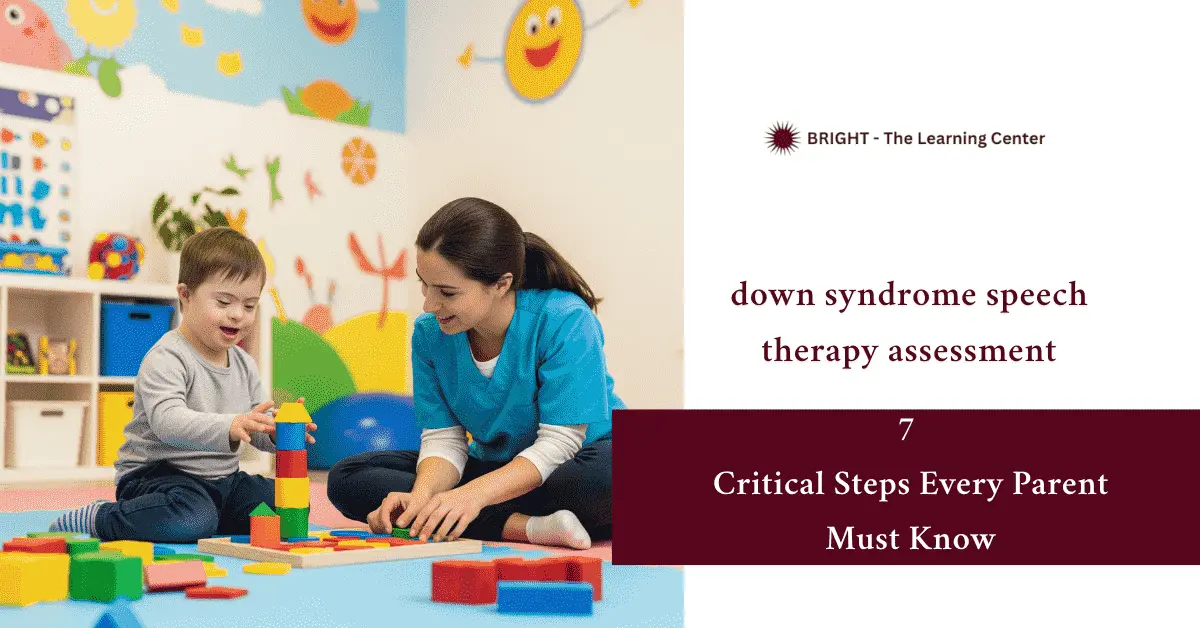Down Syndrome Speech Therapy Assessment lays the groundwork for identifying speech challenges and unlocking communication potential. This article explores how assessments guide early intervention, shape therapy plans, and support lifelong language growth for children with Down syndrome—one meaningful word at a time.
Table of Contents
Spotting Early Speech Delays
Down Syndrome Speech Therapy Assessment begins with one crucial step: recognizing early speech delays. These signs often whisper before they shout—miss them, and precious time slips away.
Children with Down syndrome may experience slower speech development. Delays can appear as early as infancy and stretch through toddlerhood. While each child progresses differently, certain signs raise red flags.
Key signs of early speech delay in Down syndrome:
- Limited babbling beyond 9 months
- Delayed first words, often after 18–24 months
- Struggles to imitate sounds or gestures
- Weak response to verbal cues or their name
- Rarely combines words by age 3
When understanding appears stronger than spoken output, deeper evaluation is necessary. That’s when a Down Syndrome Speech Therapy Assessment becomes essential. Early recognition isn’t just helpful—it changes the course of communication.
Role of the Speech Pathologist
Down Syndrome Speech Therapy Assessment depends on the expert insight of a speech pathologist. But what exactly do they bring to the table?
These professionals are not just trained in language—they assess how a child forms, understands, and uses it. They analyze everything from sound clarity to nonverbal cues, providing a full picture of expressive language challenges.
What a speech pathologist evaluates:
- Articulation clarity
- Oral-motor movement (lips, jaw, tongue)
- Vocabulary use and consistency
- Sentence length and structure
- Gestures, eye contact, and facial expression
A Down Syndrome Speech Therapy Assessment guided by a skilled pathologist uncovers both issues and opportunities. Their role is not to label—but to lead with knowledge and compassion.
Down Syndrome Speech Therapy Assessment Basics
Down Syndrome Speech Therapy Assessment provides the diagnostic foundation for meaningful intervention. It identifies where a child stands and what barriers limit their communication.
The assessment isn’t a single test—it’s a process combining interviews, observation, and clinical tools.
Core components of the diagnostic process:
- Case history review
- Caregiver interviews
- Standardized speech testing
- Oral-motor function checks
- Play-based language observation
This assessment helps clarify the gap between understanding and expression. That clarity gives families and therapists the power to act with purpose.
Why Early Intervention Wins
Down Syndrome Speech Therapy Assessment is most powerful when followed by early intervention. Why wait, when the brain is most adaptable in the early years?
Language influences more than just speech—it shapes learning, relationships, and emotional well-being.
Early intervention often leads to:
- Faster vocabulary growth
- Better sound clarity
- Stronger turn-taking and engagement
- Improved understanding and output balance
- Fewer frustration-related behaviors
Early action saves effort later. Start strong, and every step forward becomes easier.
Tools That Guide the Evaluation
Down Syndrome Speech Therapy Assessment depends on the right tools—because assumptions can mislead.
Speech pathologists combine structured tests with natural observations to get a full communication profile.
Common tools and techniques include:
- Receptive and expressive language tests
- Oral-motor assessments
- Developmental milestone checklists
- Speech sound inventories
- Observational play analysis
These tools bring accuracy. Combined with professional insight, they turn scattered signals into a clear path forward.
Building a Custom Therapy Plan
Down Syndrome Speech Therapy Assessment leads directly to the next step: action. The results must drive a personalized, strategic plan.
Each child’s challenges differ. Therapy should reflect that—not force them into a mold.
What shapes a therapy plan:
- Assessment data
- Family priorities
- Realistic goals
- Session frequency and setting
- Use of visual supports or AAC
When based on assessment insights, therapy plans become dynamic—not fixed. They evolve with the child.
Setting Speech Goals That Work
Down Syndrome Speech Therapy Assessment helps set goals that matter—real goals for real life.
The aim is functional communication: asking for help, saying no, joining a game.
Effective therapy goals may focus on:
- Core words like “go,” “stop,” or “more”
- Clarity of key speech sounds
- Building short phrases
- Practicing social cues
- Integrating AAC when needed
Each goal links directly to daily needs. That’s how therapy becomes transformative.
Turning Assessment Into Action
Down Syndrome Speech Therapy Assessment must lead to implementation. Otherwise, insight fades into inactivity.
Steps that follow the assessment:
- Review findings with the therapist
- Outline short- and long-term goals
- Choose session settings
- Build a consistent schedule
- Track and adjust as progress unfolds
Information alone isn’t power—action is. Turn data into steps, and speech into success. Children with Down syndrome aren’t the only ones who benefit from early and strategic speech therapy. If you're exploring support for autism spectrum disorders, our guide on speech therapy for autism near me outlines how localized care can make a real difference.
Book a Trusted Speech Therapist Nearby
Down Syndrome Speech Therapy Assessment is most effective with expert support. A certified speech pathologist is more than a technician—they’re a guide through the child’s communication journey.
When choosing a professional, look for:
- Relevant experience
- Valid credentials
- Structured therapy plans
- Transparent communication
- Location and scheduling flexibility
Schedule a consultation. A single session can light the path ahead. Speech is connection—start building it today.
Frequently Asked Questions
How to do speech therapy for Down syndrome?
Speech therapy involves targeted exercises to improve speech sounds, language understanding, and communication using spoken words, visuals, or AAC tools.
What is involved in a speech therapy assessment?
It includes case history, standardized tests, oral-motor exams, and play-based observations to evaluate receptive and expressive language skills.
What are the goals of Down syndrome speech therapy?
Goals focus on improving clarity, expanding vocabulary, building sentence structure, and supporting functional communication in daily life.

